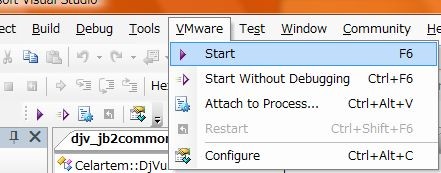VMware Workstation 6.0の新しい機能
- Integrated Virtual Debuggers — With the new Workstation IDE (integrated development environment) plug-ins, software developers are provided with menu items and toolbar buttons in Visual Studio (Windows only) or Eclipse (Windows or Linux) to easily develop and debug programs in virtual machines.
- Appliance View for Virtual Appliances — Rather than having users see a console view for an appliance, you can now configure the new appliance view. It gives you a brief description of the type of server or appliance and provides a link that opens the browser on the guest system and connects to the correct port for the server console.
- Run Virtual Machines in the Background — You can now leave virtual machines and teams running in the background when you exit Workstation. On the host, a system tray icon indicates how many virtual machines are running in the background. Click the icon to open a virtual machine.
- Enhanced File Sharing and Copy and Paste Functionality — You can now use shared folders on a Solaris guest. You can copy and paste text and files between Linux and Windows hosts and guests.
- Cross-Platform Drag-and-Drop Functionality — You can now drag and drop files and directories from a Linux or Windows host to a Linux or Windows guest, and vice versa.
- Virtual Machines Can Act as VNC Servers — You can set a virtual machine to act as a VNC server without having to install any specialized VNC software in the guest.
- Battery Information Is Now Reported in the Guest — If you use a laptop to run a guest in full screen mode, you will now be able to see status information about the host's battery.
- Increased RAM Support — The previous limit of 4GB total RAM that could be used for all virtual machines combined has been removed. The amount of memory used by all virtual machines combined is now limited only by the amount of the host computer’s RAM and page file size. The maximum amount of memory that can be allocated per virtual machine has been raised from 3.6GB to 8GB.
- Support for Paravirtualized Linux Kernels — If you have a VMware VMI (Virtual Machine Interface) 3.0 enabled kernel in a Linux guest operating system, you can now enable paravirtual support in the virtual machine.
- User Interface for Mapping a Virtual Disk to a Drive Letter on the Windows Host
- Support for High-Speed USB 2.0 Devices
- Improved 64-bit Guest Support — Intel EM64T VT-capable processors are now fully supported.
- New 64-bit Sound Driver
- VMware Player 2.0 — The new Player Welcome page gives you the option of browsing to a virtual machine file or downloading a virtual appliance from the VMTN (VMware Technology Network) web site. You can then use Player’s new appliance view when running a virtual appliance.
個人的には、デバッガ統合、準仮想化のサポート、VNCサーバあたりに興味がある。
細かいところでは、バッテリ情報をゲストに渡す機能などは、パワーマネジメントにも利用できるのか気になる。
仮想ディスクをマウントできる機能は、今まで、他のツールで提供されていた機能が統合されたのか?
